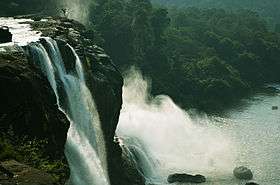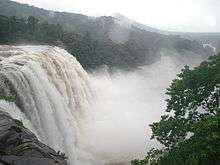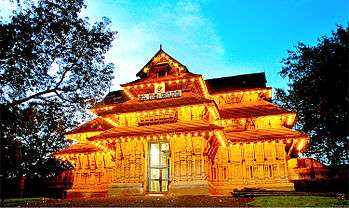Athirappilly Falls
| Athirappilly Water Falls | |
|---|---|
| അതിരപ്പിള്ളി വെള്ളച്ചാട്ടം | |
| Location | Athirappilly, kerala, India |
| Coordinates | 10°17′5″N 76°34′7″E / 10.28472°N 76.56861°ECoordinates: 10°17′5″N 76°34′7″E / 10.28472°N 76.56861°E |
| Type | Segmented |
| Elevation | 120 m (390 ft) |
| Total height | 25 m (82 ft) |
| Number of drops | 4 |
| Total width | 100 m (330 ft) |
| Average flow rate | 52 m3/s (1,836 cu ft/s) |
Athirappilly Falls is situated in Athirappilly panchayath, Chalakudy Taluk in of Thrissur district, Kerala on the southwest coast of India. Located on the west-flowing Chalakudy River near the Vazhachal Forest Division and the Sholayar ranges, this 24-metre (80 ft) waterfall and the nearby Vazhachal Falls are popular tourist destinations. There is another waterfall on the way from Athirappilly to Vazhachal Falls, in close proximity to the road and is locally called “Charpa Falls”. Athirappilly Falls is the largest waterfall in Kerala and is nicknamed "The Niagara of India".[1] Controversy about a state-proposed hydroelectric dam on the Chalakudy River above the waterfalls began in the 1990s and has continued through 2011.

River
The 145 kilometres (90 mi) long Chalakudy River, originates in the Anamudi mountains of the Western Ghats[2] and flows through the Vazhachal Forest toward the Arabian Sea. The river initially runs smoothly but becomes more turbulent as it nears Athirappilly. At Athirappilly Falls, the water surges around big rocks and cascades down in three separate plumes. Below the falls, the river remains turbulent for about 1 kilometre (0.62 mi) until it reaches Kannamkuzhi. Then it calms and flows smoothly until reaching the dam at Thumburmuzhi.

Wildlife

Forest wildlife in the area includes the Asiatic elephant, tiger, leopard, bison, sambar, and lion-tailed macaque. The unique 180 metres (590 ft) elevation riparian forest in the Athirappilly-Vazhachal area is the only location where all four South Indian species of hornbills — the great hornbill (the state bird of Kerala), Malabar pied hornbill, Malabar grey hornbill, and the Indian grey hornbill are found living together. If the proposed 163-MW Athirappilly hydroelectric project is built, these unique birds may vanish from these forests because it will submerge the hornbills' habitat.[3]
Plantations in the area contain teak, bamboo, and eucalyptus. Environmentalists claim that Athirappilly is a one-of its-kind riparian ecosystem in Kerala. V.S. Vijayan, Chairman of the Kerala State Biodiversity Board and former Director of the Salim Ali Centre for Ornithology and Natural History (SACON), Coimbatore, has been quoted in Down to Earth magazine as affirming that the Vazhachal forest division is the second most biodiverse area in the State. The International Bird Association has declared it an ‘Important Bird Area' and the Asian Nature Conservation Foundation has recommended that the area should be declared a sanctuary or a national park, he points out. The Wildlife Trust of India says it represents one of India's best elephant conservation efforts. “Any disruption to this fragile ecosystem will spell disaster,” says Vijayan. [4] The river provides habitat for 85 species of fresh water fishes. Among these, 35 are endemic species. This place is the best place to find most animals in the wild.
Tourism






The railway station nearest Athirappilly Falls is 30 kilometres (19 mi) to the west in Chalakudi Railway Station, and the nearest airport is Kochi International Airport, about 55 kilometres (34 mi) southwest of the waterfall and 58 kilometres (36 mi) south of City of Thrissur.[5] Athirappilly is easily reachable from Chalakudy by taxi or by bus from the Chalakudy private bus terminal. Athirappilly is situated on the highways connecting Tamil Nadu and Kerala, amidst thick forest, so night riding is not advised.
The journey from Chalakudy to the Athirappilly Falls passes through a landscape of winding roads, small villages and lush green trees. Visitors can reach the top of the waterfall via a paved path that leads through thick bamboo clusters. A steep narrow path also leads to the bottom of the falls. The falls attract visitors from across India, especially during the monsoon months (June–September). About 7 million tourists visit the falls and the Vazhachal picnic spot each year.[6]
Jungle Safari
Daily Jungle Safari trips are organized by Thrissur District Tourism Promotion Council with Athirappilly Destination Management Council from Chalakudy to Malakkappara. It is the most attractive wildlife watch and Ecotourism Jungle safari through the evergreen forest of Sholayar ranges of Western Ghats - Kerala. It is also the most beautiful Jungle Saffari watching Wildlife in the entire Kerala and is about 90 km across the rain forests of Sholayar ranges. A unique opportunity to experience the rich flora & fauna of Athirappilly - Vazhachal Ecotourim , covering Kauthukapark, Thumboormuzhy Dam & Butterflygarden, Athirappilly water falls, Vazhachal falls, 40 km of amidst thick forests, valleys, lofty peaks, tea garden and wildlife watch. This Jungle safari is a memorable experience ,which one can have on his Kerala visit.
Movies
The scenic beauty of Athirappilly falls has always been attractive to filmmakers.
- This falls is used as a location for several Malayalam films.
Some of the other known major films with scene(s) around the falls are :
- A major portion of 1986 Tamil movie Punnagai Mannan was shot near the falls, the falls itself playing a role in it. It made the falls so popular in Tamil Nadu that it got the nickname "Punnagai Mannan Falls".
- The falls were featured in Mani Ratnam's Bollywood film Dil Se.., starring Shahrukh Khan, Manisha Koirala, Preity Zinta ; song : "Jiya jale".
- The 2007 Bollywood movie Guru used Athirappilly Falls as one of its locations. Rajiv Menon, the cinematographer of the movie, chose Athirappilly Falls as a background for one of its songs Barso Re.
- The falls are also famous as a site location for "Narumugaye Narumugaye", a song from the Tamil film Iruvar acted by Mohanlal and actress Aishwarya Rai.
- This falls is also a major location for songs like "Behne de"and most scenes in the Hindi film Raavan and Tamil Film Raavanan.
- The song "Adada Mazhaida" from Paiyaa featuring Karthi and Tamannaah was shot in this location.
- Song from Kannathil Muthamittal of the same name shot here
- Song "Kurukku Siruthavale" from Mudhalvan starring Arjun,Manisha Koirala and "chalo chalain mitwa" for its remake Nayak (2001 film) starring Anil kapoor,Rani Mukerji
- Song "Sunta hai tera khuda" from Pukar (2000 film) starring Anil Kapoor
- Song "Achi lagti ho" from Kuch Naa Kaho
- Sirf Tum movie starring Sanjay Kapoor, Sushmita Sen
- Songs from Saaya (2003 film) starring John Abraham
- Scene from Madras Cafe starring John Abraham
- Few scenes in Hindi movie Agyaat
- Song "Rosappoo chinna rosappoo" from Suryavamsam
- "Arjuna Arjuna" song featuring Sarathkumar and Namitha in the movie Aei was shot here.
- Song "Baarish" and climax scenes from Yaariyan
- Song "oru kannil vegam" from Samar (2013 film)
- Song "Oh kamini" and scene from Rang Rasiya
- Telugu movie Brindavanam (film)
- Song "Egire Mabbullona" from Happy (2006 film) telugu and malayalam
- Song "Ayyo Ayyo Dhanayya" from Ready (2008 film)
- Scenes from tamil movie Alex Pandian
- Song aaayi re aayi re khushifrom Khushi (2003 Hindi film) starring Kareena Kapoor
- Title song of hindi movie Chura Liyaa Hai Tumne
- Song "Vaana Chinukulu" from telugu movie Seethamma Vakitlo Sirimalle Chettu
- English 2007 movie Before the Rains
- English 2008 movie Pirate's blood
- Scenes from malayalam movie Cousins
- Scenes/Song from "Baahubali", India's biggest motion picture, 2015 Telugu movie.
- Tamil movie Puli (2015 film)
- Rock On Bro Song from Janatha Garage (Telugu Film 2016)
Hydroelectric project
In 1994, the Kerala State Electricity Board (KSEB) proposed a 163 megawatt Athirappilly Hydro Electric Project. It was to include a dam 23 metres (75 ft) high and 311 metres (1,020 ft) wide on the Chalakudy River in the Vazhachal Forest Division about 5 kilometres (3 mi) upstream of Athirappilly Falls and 400 metres (1,312 ft) upstream of Vazhachal Rapids (Vazhachal Falls).[7] However, environmental groups and people's collectives opposed the project on grounds that it would damage the environment, infringe on human rights, and threaten tourism.[8] Though it was not their main concern, critics also noted that if the entire course of the river were diverted to make electricity, the Athirappilly-Vazhachal waterfalls could dry up. To avoid damaging the falls, the KSEB proposed adjusting the water releases to maintain the falls.[9] The debate continued in 2007. Environmentalists also expressed concern over whether the proposed hydroelectric project at Athirappilly waterfalls would lead to displacement and eventual extinction of the primitive tribal group, `Kadars,' in the area. [10]
In 2005, the Kerala Ministry of Environment and Forests approved the project on the basis of a report by Water and Power Consultancy Services (India) Ltd. (WAPCOS), an environmental impact assessment (EIA) agency. In 2006, the Kerala High Court quashed the clearance and ordered another public hearing.[11][12] The debate continued the following years.
On 29th Jan 2011, the chairman of the Western Ghats Ecology Expert Panel (WGEEP) Madhav Gadgil opined that the Environment Impact Assessment (EIA) of the Athirappilly hydel power project was not properly carried out and 70% of it is bogus. The panel, appointed by the Union Ministry of Environment and Forests, was asked to look into and give recommendations on various projects in the Western Ghats such as the hydroelectric projects in Gundiya in Karnataka and Athirappilly in Kerala and the overall development projects in Ratnagiri and Sindhudurg districts of Maharashtra. Gadgil said that the proposed Athirappilly hydro-electric project cannot be approved until the Forest Rights Act is implemented in its true spirit for the Kadar tribal community of the area and also no comprehensive study had been carried out so far on the natural riparian forest vegetation along the Western Ghats.[13][14][15] On 14th Jun 2011, Union Minister for Environment and Forests Jairam Ramesh said his ministry would not grant approval to the Athirappilly hydro electric project.[16] The Minister also stated “When states are denied such projects on larger and long-term environmental considerations, they are entitled to some sort of green bonus,”[17] The first part of WGEEP report was submitted to the Ministry on August 31.The Western Ghats Ecology Expert Panel (WGEEP), on Sep 6th 2011 recommended to the Union Ministry of Environment and Forests against granting permission to carry out any construction activities at the sensitive Athirappilly-Vazhachal region. The panel, which submitted its report to Union Environment Minister Jayanti Natarajan in the Capital, named Athirappilly as one of the 18 eco-sensitive localities (ESL) in the state.[18] But K. Radhakrishnan, a Former Member (Generation), KSEB, has opined that this panel report was highly biased with vested interests and the project was eco-friendly doing minimum damage to environment and forests.[19][20][21] While there are reports from renowned experts from Kerala State Biodiversity Board that the power project would adversely affect the ecology of the area and the estimated power output would be dependable upon the rainfall and dry summer seasons, which is undependable in its own way. M. Sivasankar, a KSEB chairman and MD states the need of more environment-friendly power projects with lower operating cost and higher output like super critical boiler plants. Cheemeni Power Project which is planned to produce 1500 MW is such a project in the government binders.[22]
See also
Notes and references
- ↑ "The Times of India: Latest News India, World & Business News, Cricket & Sports, Bollywood". The Times Of India.
- ↑ "Athirappilly - Vazhachal." Suni Systems (P) Ltd. Retrieved on August 3, 2007.
- ↑ Mini Muringatheri (2011-02-19), "Athirappilly project threatens hornbills", the Hindu, S & T » ENERGY & ENVIRONMENT, Chennai, India: Kasturi & Sons Ltd
- ↑ KG Kumar (2011-02-17), "Biodiversity in danger?", the Hindu, Business Line, Kochi
- ↑ "Athirappilly and Vazhachal." Official Website of Department of Tourism, Kerala. Retrieved on August 3, 2007.
- ↑ "Major Tourist Attractions." Archived January 2, 2007, at the Wayback Machine. Government of Kerala, Divisional Forest Office, Vazhachal. Retrieved August 4, 2007.
- ↑ "Environmental clearances quashed." Archived May 26, 2006, at the Wayback Machine. The Indus Telegraph, March 30, 2006. Retrieved August 5, 2007.
- ↑ "Protests mark hearing on Athirappilly project." The Hindu, June 16, 2006. Retrieved on August 3, 2007.
- ↑ The Hindu, June 16, 2006
- ↑ "Kadar tribe faces threat of displacement" The Hindu, February 20, 2006.
- ↑ "Public hearing on Athirappilly project today." The Hindu, June 15, 2006. Retrieved on August 3, 2007.
- ↑ "Athirappilly: panel interacts with people." The Hindu, April 14, 2007. Retrieved on August 3, 2007.
- ↑ "Kadar's community rights not recognised: Gadgil " The Hindu, January 30, 2011.
- ↑ "70% of EIA report bogus, says Gadgil." The Hindu, January 31, 2011.
- ↑ "Fears on Athirappilly EIA proved true, says Viswom." The Hindu, February 1, 2011.
- ↑ "No nod to power project and stadium in Kerala: Ramesh" Business Standard, June 14, 2011.
- ↑ "Athirappilly project: Ramesh moots green bonus" IBNLive, June 14, 2011.
- ↑ "Athirappilly Project to remain a pipe dream" IBNLive,September 8, 2011.
- ↑ "Panel report on Athirappilly project biased"- K Radhakrishnan,"The Hindu",January 1, 2012
- ↑ "Bid to torpedo power projects alleged" "The Hindu", January 2, 2012
- ↑ "Gadgil panel report biased: pensioners’ forum" "The Hindu", October 29, 2013
- ↑ http://www.deccanchronicle.com/nation/in-other-news/310516/kerala-growing-powder-divide.html
External links
| Wikimedia Commons has media related to Athirappilly Falls. |
- Chalakudy River Protection Forum (CPF)
- Athirappilly - Vazhachal - Thumboormuzhi - Destination Management Council
- Official Site: www.thrissur.nic.in
- Thrissur Website www.trichur.com
- Athirappilly Projects
- Vanishing falls
- Protests mark hearing on Athirappilly project
- Salim Ali Foundation
- Travel with Bollywood in Kerala
- Best Places to Visit Valparai
